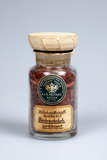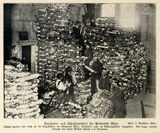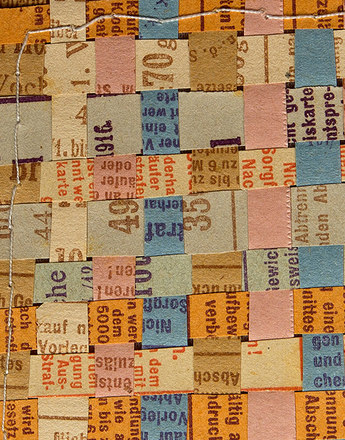-

Chopped quebracho wood, H. & M. Oesinger, Rotzok near Prague, around 1910-1918
Copyright: Technisches Museum Wien
Partner: Technisches Museum Wien -

Leather finishing agent, Fernolendt company, Vienna, around 1900-1918
Copyright: Technisches Museum Wien
Partner: Technisches Museum Wien -

Ausgabe von Kriegsschuhen an Bedienstete des Wiener Magistrats, Foto aus: Österreichs Illustrierte Rundschau, Ausgabe vom 30. August 1917
Copyright: Wienbibliothek im Rathaus
When supplies dried up soon after the start of the war, the former reliance on some unremarkable raw materials from far-off lands became clear. Among them were quebracho wood from Argentina, which had lots of tannin and was used for tanning leather, and wax from the carnauba palm in Brazil, which was used to care for leather.
The old craft of tanning was not as susceptible to industrialisation as other sectors. Home-grown materials like spruce and oak bark or acorn cups were used as tanning agents. The tanning of thick animal hides in pits took up to three years. It was not until the early twentieth century that rapid tanning spread from western Europe. Now increasingly concentrated natural substances with exotic names started arriving in Austria: mangrove bark from Madagascar, mimosa bark from South Africa, divi-divi from Mexico and, above all, tannin-rich quebracho from Argentina. This was processed into tannin extract in Austria, the largest company being H. & M. Oesinger in Roztok [Roztoky] north of Prague. Other quebracho-processing factories were located conveniently on the Austrian Adriatic coast. With the loss of overseas deliveries, local tanning agents had to be used again. Experts at the Leather Industry Research Institute in Vienna experimented with oak and chestnut, various barks, spruce cones and tree fruits. They also took a critical look at substitute tanning agents mixed with cheap substances and waste products like molasses or wood pulp lye.
Leather was a strong and durable material and played an important role in the war, notably for army shoes and boots, harnesses and belts. At the start of the war there was plenty of leather available: large numbers of cattle were slaughtered and many horses were killed under fearful conditions in the war. By 1915, however, soles and uppers for shoes and other types of leather for military purposes were required. The civilian population suffered thereafter from a shortage particularly of materials for soles, which were made increasingly of leather waste, wood or felt. Leather drive belts for machine transmissions were also replaced by paper and wire mesh belts.
In view of the deteriorating quality of the products, leather and shoe care became more important. Wax from the Brazilian carnauba palm was a favourite substance. In 1913 Austria-Hungary had imported 2,639 hundredweights of raw and processed carnauba wax. Among the largest users was the shoe cream manufacturer Stefan Fernolendt in Vienna. Untreated lignite wax from the domestic lignite in Bohemia was used as a substitute. In this sector as well a number of manufacturers marketed inferior-quality products, which were styled as “synthetic shoe cream”, “glycerine substitute” or “diluted fish oil”. As in many other cases, these surrogates did not live up to their promise.
Translation: Nick Somers
Der Außenhandel der öst.-ung. Monarchie im Jahre 1913, in: Österreichische Chemiker-Zeitung, Neue Folge 17 (1914), 75–79
Kohnstein, Bernhard: Über die Folgeerscheinungen des Krieges auf die Lederindustrie und die Vorkehrungen des technischen Versuchswesens, in: Mitteilungen des k. k. Technischen Versuchsamtes 4/4 (1915), 30–39
Weitensfelder, Hubert: „Kriegsware“. Ersatzstoffe in Produktion und Alltag, in: Pfoser, Alfred/Weigl, Andreas (Hrsg.): Im Epizentrum des Zusammenbruchs. Wien im Ersten Weltkrieg, Wien 2013, 172–179
-
Chapters
- Chicory, peat & Textilit: surrogates before the war
- The age of iron
- Bells for bullets: metal collection
- Fragile clothing: textiles and paper fabrics
- Well shod? Tanning agents and leather
- Rubber goods: elastic and essential
- From far and near: resins and resin products
- The 1918 surrogate exhibition in the Prater




